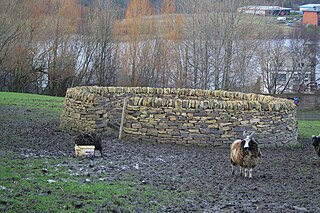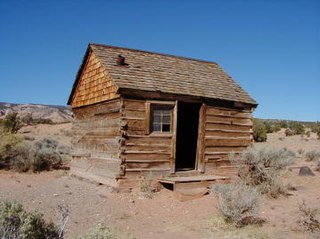 W
WThis is a list of notable corrals used to enclose horses and other livestock. In the American west, a number of historic corrals are listed on the U.S. National Register of Historic Places. Among these are corrals used to trap or hold wild horses, corrals used to support cavalry, and corrals which otherwise supported usage of horses in ranching or other activities.
 W
WA pen is an enclosure for holding animals such as livestock or pets that are unwanted inside the house. The term describes types of enclosures that may confine one or many animals. Construction and terminology vary depending on the region of the world, purpose, animal species to be confined, local materials used and tradition. Pen or penning as a verb refers to the act of confining animals in an enclosure.
 W
WThe Cathedral Valley Corral was constructed around 1900 by local cattlemen in the northern portion of what is now Capitol Reef National Park in Utah. It is one of the oldest examples of ranching use in the park. It coincided with a change in the use of the land, where cattle were grazed on the open range and collected into corrals for branding, vaccination and other procedures. The extensive use of open-range grazing practices led to the de-vegetation of portions of the area. The corral was used by the Jeffery and Morrel families. The corral site uses sandstone cliffs as part of the enclosure, with a wood fence closing off an alcove in a cliff. The pen is subdivided into a larger and smaller enclosure, with a cattle chute off the small pen.
 W
WThe James Wild Horse Trap in Nye County, Nevada, near Fish Springs, is a historic site that is listed on the U.S. National Register of Historic Places. It was the location of a corral and fences used to capture wild horses, built out of dead Juniper trees. It is as described in a book by Will James, Sand, or Lone Cowboy, published by Charles Scribners Son's in 1930.
 W
WThe Leslie Morrell Line Cabin and Corral are located in the Cathedral Valley section of northern Capitol Reef National Park in Utah. The cabin was built in the 1920s on Lake Creek by Paul Christensen at his sawmill as a summer residence for Christensen and his family. Christensen sold the cabin to Leslie H. Morrell around 1935, who took the cabin apart and rebuilt it at its present site for use as a winter camp for cowboys on the Morrell ranch. The use continued until 1970 when the area was sold to the National Park Service. It is one of the best-preserved relics of ranching activities in the park.
 W
WThe Strap Iron Corral, located about 5.8 miles (9.3 km) north of Hooper, Washington, is a historic corral built in the 1870s by "Uncle Jim" Kennedy.
 W
WSwett Ranch, in Daggett County, Utah southwest of Dutch John, has buildings dating from 1909. A 14.1 acres (5.7 ha) section of the ranch was listed on the National Register of Historic Places in 1979. It included nine contributing buildings and three contributing structures.
 W
WThe Texas Trail Stone Corral, near Imperial, Nebraska, was built in 1874 and is a rare surviving artifact of cattle drives along the Texas Trail. It is listed on the National Register of Historic Places and as a Nebraska historic resource, NeHBS no. CH00-041.